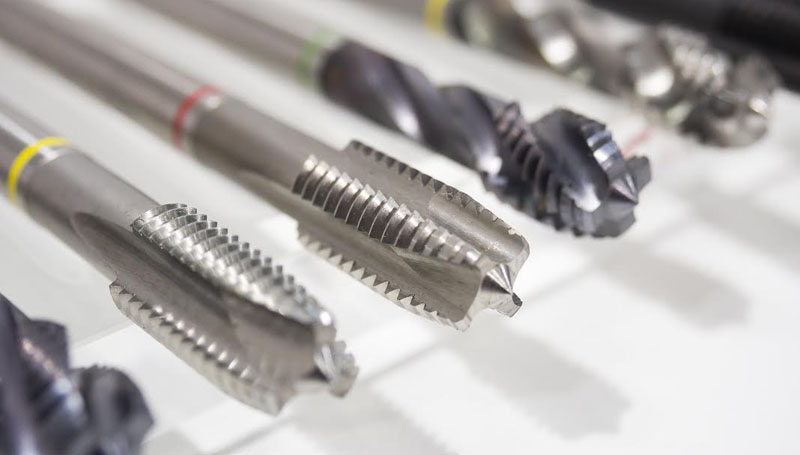1. Poor Tap Quality
Main materials, tool design, heat treatment, machining accuracy, coating quality, etc. For example, the size difference at the transition of tap section is too large or the transition fillet is not designed, which leads to stress concentration, and it is easy to fracture at the stress concentration when in use. The section transition at the junction of handle and blade is too close to the weld crater, resulting in the superposition of complex welding stress and the stress concentration at the section transition, resulting in large stress concentration, resulting in the fracture of tap in use. For example, the heat treatment process is improper. During the heat treatment of taps, if the taps are not preheated before quenching and heating, the quenching is overheated or overburned, the taps are not tempered in time and cleaned too early, which may lead to cracks. This is also an important reason why the overall performance of domestic taps is inferior to that of imported taps.
2. Improper Tap Selection
For tapping parts with too high hardness, high-quality taps should be selected, such as cobalt containing high-speed steel wire taps, cemented carbide taps, coating taps, etc. In addition, different tap designs are used in different workplaces. For example, the number, size and angle of the chip removal slot of the tap have an impact on the chip removal performance.
3. The Tap Does Not Match The Processed Material
In recent years, more and more attention has been paid to this problem. In the past, domestic manufacturers always thought that imports were good and expensive, but in fact, they were suitable. With the continuous increase of new materials and difficult processing, in order to meet this need, the variety of tool materials is also increasing. This requires the selection of appropriate tap products before tapping.
4. The Hole Diameter Of Bottom Hole Is Too Small
For example, processing ferrous material M5 × When using the cutting tap for 0.5 thread, the drill with the selected diameter of 4.5mm should be used to drill the bottom hole. If the drill with the wrong diameter of 4.2mm is used to drill the bottom hole, the cutting part of the tap must be increased during tapping, and then the tap will be broken. It is recommended to select the correct bottom hole diameter according to the type of tap and the material of tapping parts. If there is no fully qualified drill, you can choose a larger one.

5. Tapping Material Problem
The tapping piece is made of impure material, and there are local hard spots or pores, resulting in the tap instantly losing balance and breaking.
6. The Machine Tool Does Not Meet The Accuracy Requirements Of The Tap
Machine tools and clamping bodies are also very important, especially for high-quality taps. Only machine tools and clamping bodies with a certain accuracy can play the role of taps. It is common that the concentricity is not enough. At the beginning of tapping, the starting and positioning of the tap is incorrect, that is, the spindle axis is not concentric with the center line of the bottom hole, and the torque is too large during tapping, which is the main reason for the tap breaking.
7. Cutting Fluid And Lubricating Oil Are Of Poor Quality
Many domestic enterprises have begun to pay attention to this. Many companies that purchase foreign cutting tools and machine tools have a very profound experience. There are problems in the quality of cutting fluid and lubricating oil, and the quality of processed products is prone to burrs and other adverse conditions. At the same time, the service life will be greatly reduced.
8. Unreasonable Cutting Speed And Feed Rate
When there are problems in processing, most domestic users reduce the cutting speed and feed rate, so the driving force of the tap is reduced, and the thread accuracy of its production is greatly reduced. This increases the roughness of the thread surface, and the thread aperture and thread accuracy can not be controlled. Of course, problems such as burrs are more inevitable. However, if the feeding speed is too fast, the excessive torque will easily lead to the breakage of the tap. The cutting speed during machine tapping is generally 6-15m/min for steel, 5-10m/min for Quenched and tempered steel or hard steel, 2-7m/min for stainless steel and 8-10m/min for cast iron. For the same material, the smaller tap diameter takes the higher value, and the larger tap diameter takes the lower value.
9. The Technology And Skills Of The Operators Do Not Meet The Requirements
The above problems require operators to make judgments or give feedback to technicians, but most domestic operators do not pay enough attention to them at present. For example, when processing blind hole threads, when the tap is about to contact the bottom of the hole, the operator does not realize that it is still fed at the tapping speed when it does not reach the bottom of the hole, or it is forced to feed when chip removal is not smooth, causing the tap to break. It is suggested that operators should strengthen their sense of responsibility.
It can be seen from the above that there are various reasons for the breakage of taps, including machine tools, fixtures, workpieces, processes, chucks and cutters, etc. the real reason may never be found by mere talking on paper.


